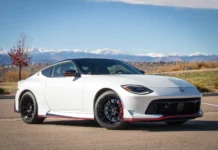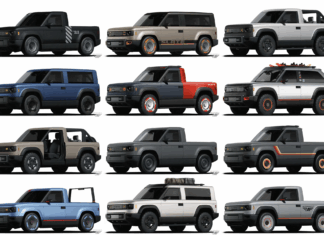
The third-generation Mazda CX-5 literally grows up from the previous model.
Over the past few years, we’ve seen Mazda replace its aging SUVs with brand-new models (with new names to match), like the CX-30 and CX-90/CX-70. It stood to reason the automaker would make a similar play when it launched the CX-50, eventually phasing out the original CX-5 in favor of its larger, more lifestyle-minded sibling. But it’s not quite that easy, as the CX-5 has long been Mazda’s cash cow — and it’s most compelling option among a sea of compact crossovers. So we are indeed getting a new CX-5 that builds on the solid foundation laid by the first two generations, with a few key changes to make its bestseller even better…as well as one notable omission.
The 2026 Mazda CX-5 is an evolutionary case, and you can see that right off the bat. Its overall profile and “Kodo” design remains fairly true to the second-generation (2017-2025) model, but there are noteworthy changes to mention. You get the usual tweaks with a heavy update or generational overhaul, including revamped front and rear fascias. Looking at its face, you’ll notice a new clip with a distinctive LED running light design that adds on to what we had with the old model. At the back, Mazda is taking a classier approach by using its new script across the tailgate (though the winged M badge is still on the grille), and fitting a new set of slim taillights.
Overall, this new CX-5 is 4.5 inches longer than the old car, and rides on a 3-inch longer wheelbase. That’s meant to help cure one of its biggest drawbacks: a lack of interior space against high-volume contemporaries like the Toyota RAV4 and Honda CR-V. The 2026 CX-5’s length now stands at 185.6 inches, which also puts it right in line with the formerly larger CX-50 too. Mazda hasn’t shared any additional dimensions yet, but you’ll see that extra length in the rear doors, and the company notes you’ll also enjoy better cargo space against the outgoing model.
Mazda gives in to the big touchscreen revolution
The larger stature aims to give the 2026 Mazda CX-5 a better practical pitch against its rivals, but another complaint over the years has been the MazdaConnect infotainment system. As a several-time owner (and the admitted Mazda fanboy on the TFL team), I didn’t mind the command dial-based system and thought it relatively straightforward to use, but it appears to be completely out the window here. Instead, this new model brings in an available 15.6-inch touchscreen replacing the old 10.3-inch unit. This large screen seems to omit physical buttons entirely — even losing the volume knob that was part of the old system, mounted on the center console. By default, though, you’ll get a new 12.9-inch display, while all CX-5 models will get standard Google built-in apps and wireless Apple CarPlay/Android Auto support.
Again, broadly speaking, the 2026 Mazda CX-5’s interior design doesn’t stray too far from the old car, as you still get a range of nice-looking leather and a premium look. The steering wheel gets a similarly sleek look to the infotainment screen, with Mazda leaning away from physical buttons (for better or worse…we’ll have to see when we actually test it). Weirdly, media controls notwithstanding, the center console looks pretty much the same as the old car, right down to the conventional shifter.
You’ll have a 2.5-liter engine or nothing at all until 2027
When it hits dealerships later this year, the 2026 Mazda CX-5 will get an all-too-familiar powertrain. Say it with me: 2.5-liter SkyActiv-G with 187 horsepower and 185 lb-ft of torque. The 6-speed automatic transmission stays too, as does the standard i-Activ all-wheel drive. There are a few software tweaks, but otherwise the powertrain carries over completely unchanged.
Here’s the rub, though: For now, this is all Mazda plans to offer with the new CX-5. The turbocharged version of the same 2.5-liter engine is no longer on the menu, which is a baffling decision as far as I’m concerned. Not only does it offer a good deal of punch, but removing it takes away one competitive advantage the CX-5 has in the class. Mazda says the take rate for the CX-5 Turbo was fairly low anyway — even around 10% at some points — but in an age of Toyota RAV4 GR Sports and even the 1.5-liter Nissan Rogue offering more than 200 horsepower, this feels like a bit of an unforced error. If you’re going to carry over the N/A powertrain, why not just bring the turbo too for those who want it? (Granted, the turbo’s fuel economy isn’t the greatest anyway…so that could well be another contributing factor to its absence here.)
All that said, Mazda does have an ace up its sleeve with the new CX-5: a hybrid powertrain. This time around, unlike the CX-50 Hybrid, its city-slicker sibling will use an in-house setup. When it does arrive, the so-called “SkyActiv-Z” setup should offer more power and better fuel economy than the base gas engine, though here’s the other rub: It won’t arrive until 2027. And if you are a Mazda fan like me, you’ll remember the automaker’s tendency to delay then outright cancel powertrains (remember “SkyActiv-X” and the short-lived CX-5 diesel?)…so I personally hope the company sticks to that time frame here. Whether it really wants to or not, the automaker needs hybrid options, which is why it put together the CX-90 PHEV and sourced a Toyota system for the CX-50 Hybrid. This time around, then, I’m confident we will see a CX-5 Hybrid, though we’re still in for a wait.
While the gas-only model should arrive later this year or in early 2026, we don’t yet know how much the 2026 Mazda CX-5 will cost. Given the current economic climate, it’s a question mark whether pricing will stay close to what we know now. That said, it needs to be competitive, so Mazda may keep the base model somewhere in the low-$30,000 range. We’ll have more information on trims and pricing as we get closer to the launch.



























